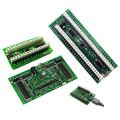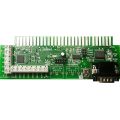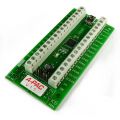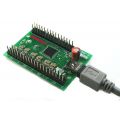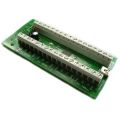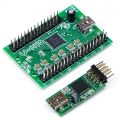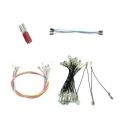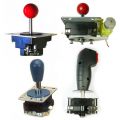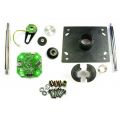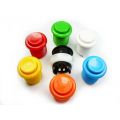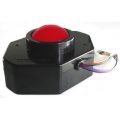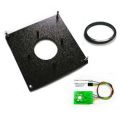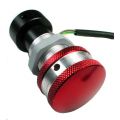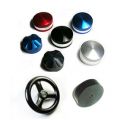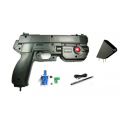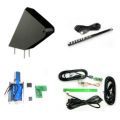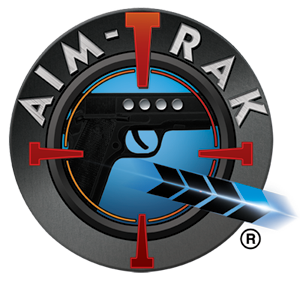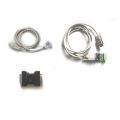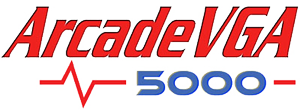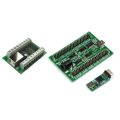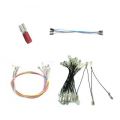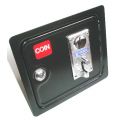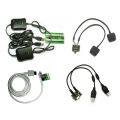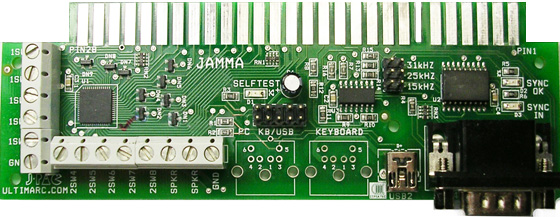
New Version!
- NEW VERSION! Now has inputs fully protected against static discharge and reverse connection, now supports 3 extra JAMMA connections (Tilt, Service SW and Test)
- Now supports 12 volt coin doors.
- Fully programmable key code set. Stored even after power off.
- Dual interface USB or Keyboard.
- Supports I-PAC optional pre-assembled LED harness with 3 panel mounting LEDs which emulate the keyboard Lights.
- Lead plugs into keyboard socket on PC or USB port.
- Self-Test LED gives an instant check of all your wiring. Can indicate which, if any, input has a problem.
- No separate power needed.
- Does not use a matrix - no ghost keys. All inputs are completely separate and generate their own interrupt - this is the fastest possible method.
- Does not use a scanning method which causes a variable delay.
- Either uses standard MAME keys or you can program your own character set.
- Shift functions. Holding "Start1" and pressing other buttons sends a range of codes for MAME functions such as "escape", "Coin 1", "tab", "enter". This means no extra buttons are needed on the cabinet. In programmable mode any input can be the shift key and all keys can be programmed with a shifted code.
- Connector for ordinary keyboard which can be used together with the controls if required.
- No special drivers needed. USB drivers are generic Windows.
- All control inputs which are part of a normal JAMMA standard are routed to an on-board JAMMA edge connector.
- Connector for VGA input from PC VGA card. Routes through to JAMMA edge connector for connection to the cabinet arcade monitor.
- On-board video amplifier boosts signal to standard arcade monitor levels. Uses high-bandwidth video amplifier chip.
- Custom microcontroller only allows sync signals to be sent to the monitor if they are in the correct range that the monitor is designed for. Avoids driving the monitor with a too-high horizontal sync rate which can damage some arcade monitors.
- Sync circuitry also converts separate horizontal and vertical syncs into composite sync. Can handle both positive and negative vertical sync.
- If required, can divide a 31Khz VGA signal in half so that it will display a stable picture on a 15Khz arcade monitor. Useful for checking boot-up progress and configuration (not for application use). Automatically stops dividing the signal when it detects a correct 15Khz rate is being send by the PC.
- JAMMA cabinet speaker routed
to screw connectors for wiring
to powered sound card or hacked PC speakers.
Legal Note.
For legal reasons we must state here that the J-PAC is not designed to be used in revenue-earning applications where a credit mechanism is used. The J-PAC contains no specific interface functionality for any credit device. Although it has inputs which connect to the JAMMA coin signals, these are designed such that activating a switch connected to them causes the MAME "coin" keycodes (5 or 6) to be sent. These are designed to be used with panel pushbuttons not coin doors or note acceptors.
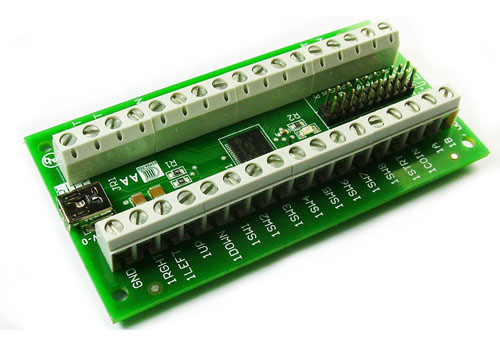
The units were designed around MAME and normally you would use a front-end menu for selecting games. But of course, as the I-PAC emulates a real keyboard (without all the drawbacks) you can use any PC application which uses keyboard input.
Yes. You can use the fully programmable code sets of I-PAC to customise for any emulator or other application. Several popular front-end menus even have integrated support for downloading I-PAC codesets on-the-fly.
NO. Using the key-code programming is entirely optional. When the board is shipped, all codes are automatically assigned to MAME standard keys. As many people have found, this makes installation very quick and easy.
One method is to hack a keyboard, i.e. connect all the controls to the keyswitches so each button appears as a key. This is pretty unsatisfactory for several reasons: It takes ages to wire up as 2 wires need to be run to each switch.
Most arcade cabs have one side of all switches commoned so you have to re-wire everything.
Key Ghosting: This happens because of the matrix nature of keyboard encoders.
Extra buttons: With this solution, with some emulators you have to have extra buttons on the cabinet for functions such as "escape", "insert coin" etc. Nobody likes drilling extra holes in their nice original arcade cab!
Speed: Keyboard encoders use a scanning method. So each key is checked in sequence for a press or release. I-PAC does not use a matrix or scanning.
Shifted function keys will do various functions ie press "1 player start" and "fire" and you will insert a coin. Press "1 player start" and "2 player start" and you will jump back to the menu. You can also use the MAME game config menus with shift buttons, ie tab and enter are shift joystick right and left. The 1 player start button is always the shift button if you are using the standard MAME codes. In programmable mode you can assign any input to be the shift button and you can program all of the buttons to have shifted codes. The unique feature of the shift function is that it requires no dedicated extra button.
When the board is shipped it contains all standard MAME codes including the shift codes mentioned above. If you only ever use MAME and want a quick and easy install this will probably do for you. But if you need to, you can re-program as required, including "on the fly", and the board will remember your new settings.
You may find you need to change the assignment of keys for other emulators or maybe you don't want to have the shift functions of the MAME code set. The code set can be changed using the WinIPAC utility.
Normally you would install and test the board before getting into programming.
Will it work on a MAC?
Yes the I-PAC will work on a MAC with USB. There is even a Mac version of the programming utility.
Will it work on a Linux host including Raspberry Pi?
Yes the I-PAC will work on a Linux host. There is third-party Linux programming utility support (see Downloads page).
What is the size of the board?
Dimensions shown below. Height is approx 17mm.


![]()
Click Here for older software versions for pre-2015 boards
Compatible with I-PAC Ultimate I/O, I-PAC 2, I-PAC 4, Mini-PAC, J-PAC. (2015-onwards boards only).

Click Here to Download Program
New boards are shipped with this version.
Latest firmware files (ver 1.55) for all 2015-onwards I-PAC, Mini-PAC and J-PAC boards plus all Ultimate I/O boards regardless of date.
I-PAC 4 has a later version 1.56 which enabled quad game controller support.
I-PAC Ultimate I/O new version 1.56 corrects an issue with mode changes not happening when trackball/spinner are connected.
NOTE: Attempting to upgrade a pre-2015 board which this firmware will render it inoperable.
All firmware now supports the Multi-Mode operation which enables switching to dual game controller mode or dual X-Input mode. Check the Multi-Mode tab on the product pages for more info.
Before upgrading ensure you have the I-PAC shift functionality enabled otherwise mode switching will not work. The default is Start1 being the shift control.
Also before upgrading to multi-mode firmware ensure the latest WinIPAC version is installed from the download page.
If the board comes up in Xinput mode after upgrading, this can be reset to standard keyboard by holding P1SW1 while connecting USB cable. See the Multi-Mode product tab on the I-PAC pages for full details.
Click here to download all Multi-Mode firmware versions, including ID#2 for the second board in dual-board UIO setups.
Version 1.56 firmware supports 4 game controllers on I-PAC 4. There is an important issue to be aware of with regards to WinIPAC support in Xinput mode, which is covered on the Multi-Mode tab page.
This is an alternative firmware version which enables the board to appear as a keyboard and dual standard game controller AT THE SAME TIME (both also with mouse). Note Retropie does not work with this configuration. The standard multiMode version (above) enables one device type at a time on the host (plus mouse) and this is required for Retropie. IMPORTANT: This version also requires a different version of WinIPAC for configuration.
This version does not support Xinput.
Unlike the Multi-Mode, this version automatically allocates each of the 2 game controllers on the respective side of the board so WinIPAC does not refer to player numbers, these are defined by the board markings. I-PAC 4 only supports 2 game controllers.
Click here to download all mixed-mode firmware versions.
Click here to download the special WinIPAC version for configuring mixed-mode boards.

Thanks to John K. Morris of Evolution Interactive for this software
Click here to download the new version for Intel Macs
Click here to download the older PowerPC version.
Linux software utilities are available. These cover several of our products and are being added-to. Please note we are not able to provide direct support for these utilities:
Linux Library and command line utilities developed by Katie Snow
| INPUT | CODE (Normal) | CODE (Start1 held) |
|---|---|---|
| 1 right | R arrow | Tab |
| 1 left | L arrow | Enter |
| 1 up | U arrow | Tilde (adj volume, gamma, etc ) |
| 1 down | D arrow | P (pause) |
| 1 B1 | L-ctrl | 5 (Coin A) |
| 1 B2 | L-alt | |
| 1 B3 | space | |
| 1 B4 | L-shift | |
| 1 B5 | Z | |
| 1 B6 | X | |
| 1 B7 | C | |
| 1 B8 | V | |
| Start 1 | 1 | |
| Start 2 | 2 | Esc |
| 2 Right | G | |
| 2 Left | D | |
| 2 Up | R | |
| 2 Down | F | |
| 2 B1 | A | |
| 2 B2 | S | |
| 2 B3 | Q | |
| 2 B4 | W | |
| 2 B5 | I | |
| 2 B6 | K | |
| 2 B7 | J | |
| 2 B8 | L | |
| Coin 1 | 5 | |
| Coin 2 | 6 | |
| Service | F1 | |
| Test | F2 | |
| Tilt | F3 |
Connections in RED are used by J-PAC. Others are not connected.
| SOLDER SIDE | COMPONENT SIDE | ||
|---|---|---|---|
| GND | A | 1 | GND |
| GND | B | 2 | GND |
| +5V | C | 3 | +5V |
| +5V | D | 4 | +5V |
| -5V | E | 5 | -5V |
| +12V | F | 6 | +12V |
| Key | H | 7 | Key |
| Coin counter 2 | J | 8 | Coin counter 1 |
| Coin lockout | K | 9 | Coin lockout |
| speaker (-) | L | 10 | speaker (+) |
| NC | M | 11 | NC |
| green | N | 12 | red |
| composite sync | P | 13 | blue |
| Service switch | R | 14 | Video ground |
| Tilt | S | 15 | Test |
| Coin 2 | T | 16 | Coin 1 |
| Player 2 Start | U | 17 | Player 1 Start |
| Player 2 Up | V | 18 | Player 1 Up |
| Player 2 Down | W | 19 | Player 1 Down |
| Player 2 Left | X | 20 | Player 1 Left |
| Player 2 Right | Y | 21 | Player 1 Right |
| Player 2 Button 1 | Z | 22 | Player 1 Button 1 |
| Player 2 Button 2 | a | 23 | Player 1 Button 2 |
| Player 2 Button 3 | b | 24 | Player 1 Button 3 |
| Player 2 Button 4 | c | 25 | Player 1 Button 4 |
| Player 2 Button 5 (J-PAC C) | d | 26 | Player 1 Button 5 (J-PAC C) |
| GND (J-PAC standard ver) Player 2 Button 6 (J-PAC C) |
e | 27 | GND (J-PAC standard ver) Player 1 Button 6 (J-PAC C) |
| GND | f | 28 | GND |
All the inputs which appear on a standard JAMMA interface are routed to the JAMMA edge connector. The inputs which appear on the I-PAC but not on a JAMMA connector are routed to screw terminals. If it is required to connect extra non-JAMMA controls, follow the wiring instructions below. The exception to the above is button 4 (both players). This appears on some non-standard JAMMA cabinet connectors and is therefore routed to screw terminals and the JAMMA edge connector. The J-PAC programming utilities are identical to I-PAC and can be downloaded fromhere.
The I-PAC LED harness is compatible with the 10-pin header on the J-PAC. The I-PAC programming instructions apply to the J-PAC. Programming is optional, the board come pre-configured with MAME keycodes.
The monitor interface performs the following functions:
- Routes all required signals from the PC VGA port to the JAMMA edge connector.
- Determines if the frequency being output from the PC is within the range for the arcade monitor. Only enables the arcade monitor sync if within safe range.
- Indicates sync status by means of LEDs.
- Converts VGA horizontal/vertical sync to composite sync.
- Automatically caters for positive and negative frame sync and converts if necessary. NOTE: It does not convert positive horizontal sync. See later.
- Can be set to divide line frequency by two so as to display a stableVGA picture on an arcade monitor for test purposes. (actually displays two pictures side by side)
To configure the monitor interface, install one jumper on the pair of pins indicating the frequency your monitor is specified to operate at.
Most older arcade monitors operate at 15 Khz. Alternatively, if a 15Khz monitor is being used, install jumpers on both the 15 and 31Khz positions (default setting). This enables a stable picture to be displayed during boot. See below.
If all jumpers are removed, the J-PAC will pass through composite sync. This mode is used with our console adaptors.
IMPORTANT: The J-PAC does not convert or process the video signal in any way except amplify it to the level required by an arcade monitor.
The sync frequency jumpers only control the sync-in-range safety check.
The PC must be configured to send the correct sync frequency for the monitor unless our ArcadeVGA card is being used.
When the SYNC OK LED is off, this indicates that no sync signal is being sent to the monitor because it is out of the correct range for the monitor.
If you wish to see a stable VGA picture during boot, set for "split screen mode". install a jumper on both the 15 Khz and 31 Khz positions.
In this mode when the PC is booted, a visible double picture should be displayed.
When the VGA frequency drops to 15 Khz the picture will return to normal. This mode is for 15 Khz monitors only. The picture may not be stable all the way from initial power-on.
The quality of this divided picture varies with monitor type and VGA card.
Some monitors may display this clearer than others and it is only intended for checking that the PC and monitor is functioning, not as a usable picture.
It may be necessary to adjust the monitor controls to a setting which is OK for both normal and test mode. It is usually possible to use this picture for DOS editing of configuration files etc.
The J-PAC does not contain any active sound circuitry owing to the JAMMA standard not providing good sound capabilities (one speaker only), nor any powerful enough voltage supply being readily available.
The JAMMA standard is mono sound. The JAMMA edge connector speaker wires are routed to screw connectors on the J-PAC. These connections can be used to connect a powered PC sound card to the cabinet speaker.
Alternatively for better quality stereo sound, simply use a normal pair of PC speakers, either powered or passive, and place inside the cabinet or wire to the cabinet speaker(s).
It is usually preferable to remove any low-voltage game board power supply which is fitted inside a JAMMA cabinet, leaving only the monitor powered from AC mains (via the cabinet isolating transformer if fitted).
With no game logic board to provide a load, most cabinet power supplies would not work anyway.
Also keeping 12 volts away from the J-PAC will eliminate the risk of damage in the event that the JAMMA connector is ever plugged in backwards.
Another alternative is to unplug the AC feed to the game board power supply. Ensure that doing this does not also disconnect the ground!
IMPORTANT: If a cabinet power supply IS still operating, make doubly sure the JAMMA connector is plugged on the correct way round otherwise the J-PAC will be damaged as 12 volts would be applied to the inputs.
Most older arcade monitors require an isolating transformer. DO NOT REMOVE THIS if fitted otherwise the cabinet and monitor frame will be directly connected to the mains power supply!
Double check the monitor frame and the control panel are directly connected to ground. If the ground is poor, a voltage could build up on the cabinet connections which is not only dangerous but will destroy the J-PAC.
Be especially careful if you have removed the power supply as this may result in breaking the grounding of the monitor which could have been routed through the power supply.
Configure the PC to run the VGA card at the correct frequency for the arcade monitor. For a standard-res monitor this will require special software and/or drivers unless you are using an ArcadeVGA card.
These drivers will be invoked during the PC boot process or start-up of an emulation front-end or emulator itself. There will therefore be a period of time at start-up when the PC will not be providing the correct output for the arcade monitor. The special circuitry on the J-PAC will ensure the monitor does not attempt to operate outside its range.
Check grounding of the cabinet before proceeding to avoid any danger/damage. The best method of doing this is as follows: Using an ohmmeter or continuity tester check for a good connection between the following points:
- Monitor frame JAMMA edge connector ground pins. These are the 4 pins at either end of the connector.
- Mains power cord ground.
- Control panel ground.
- Power supply ground if fitted.
Now connect the JAMMA connector.
Double check it is the correct way round, especially if it is not fitted with a key.
Connect the keyboard interface cable from the DIN connector marked “PC KB/USB” to the PC keyboard port or USB port.
Connect the video cable from the connector marked "PC VGA” to the VGA card.
Connect a pass-through keyboard to the connector marked “KBD” (optional).
If you are using the LED harness, plug it onto the 10 pin header. Note that one pin of the header is missing. This is to ensure the polarised plug can only be inserted the correct way round.
Connect one side of each switch to the screw terminals as indicated on PCB.
"Daisy chain" the other side of all switches together and connect to either of the "GND" terminals on PCB. Some micro-switches have 3 connections – only use the ones marked "NO" and "COM". Don't connect anything to the "NC" tag.
Below is a diagram showing an example of 3 joystick micro-switches connected to inputs on the J-PAC board.
The gauge of wire used is not critical. Any insulated stranded wire will do providing it is thick enough to be gripped by the screw connectors. The wire we supply in our wiring kit is 16 X 0.2 mm.
You can connect more than one switch to one J-PAC input, to perform the same function. For example you might want to have side flipper buttons connected to the same inputs as fire buttons as these are used in different games. This applies to joysticks too. You can connect a 4 and an 8-way stick to the same inputs. (But check our 4-8 way switchable sticks though!)


Power on the PC. The “SYNC IN” LED should light indicating the J-PAC is receiving a sync signal from the PC. The “SYNC OK” LED will light when the PC has switched into the correct video mode for the monitor, and then the monitor should display a picture.
The Self test LED flashes and then should light continuously.
It is very likely that you will need to adjust the monitor H sync, V sync and size controls, even if it was previously working with a game board.
The board automatically detects which interface it is connected to (USB or PS/2).
You do not need to install any drivers or software from the Ultimarc CD to get the board to operate.
There are no third-party drivers for the J-PAC.
When the board is first powered on, it contains a pre-loaded code set.This matches the MAME default key codes as the table above indicates. For many people there is no need to do any re-assignment, just power up and play.
You may want to re-program the codes if any of the following apply: ·
- You use an emulator or other PC application without a key re-mapper.
- You don't want people to be able to access the MAME game config menus by using shift buttons (for example game contests etc)
- You want to limit coin insert to a real coin slot rather than using shift button feature.
Boot PC into DOS or Windows and run a text program such as Notepad. Observe the self-test LED on the J-PAC which should display a flash pattern and then light continuously.
Press various player 2 buttons (some of the player 1 buttons are mapped to non-displayable codes such as ALT so best to use player 2). You should see characters displayed, just as if they were typed on the keyboard.
If in
DOS, enter COPY CON to suppress the command prompt. On a keyboard plugged into the pass-through, press CTRL-ALT-P. (press and hold each key in this order). Enter "T" in the menu to enter test mode. All pressed buttons and joysticks will be displayed on the screen. The input will be shown, followed by the code which is currently assigned, followed by the shifted code, if one is assigned. Test all buttons and joystick switches. If all OK reboot to exit. Now ready to play!
There are two methods of programming the board. The WinIPAC IPD utility can be downloaded and run from Windows or IPACUTIL in DOS See IPAC programming instuctions for details, OR you can enter the Interactive Programming and Test Mode by pressing CTRL-ALT-P on a keyboard connected to the pass through. See here for instructions. You might also have to do some setting-up in MAME because buttons 5 and 6 are not normally assigned by default in MAME and must be programmed. (press tab in any game).
Pressing and holding 1player
start enables shift mode with
access to the following keys (when "MAME" setting is used): 2
player start=Esc – for
jumping back to the menu Joystick
left=Enter – for
running games in Windows and for MAME game config menu Joystick
right=Tab – for
entering MAME config menu Joystick
up=~ - for entering MAME
volume/gamma menu Joystick down=P
MAME pause key 1 fire (button
1)=5 – for simulating
coin insert.
The above shift keys can be changed/turned off as required if the board is programmed. MAME HINT: to get past "Type OK to continue" prompt, just move joystick left then right.
PC should pass BIOS keyboard self-test with or without a normal keyboard connected. The unit is capable of being used in a closed arcade cabinet with no additional keyboard or controls and motherboard booting into an emulation menu. If an auxiliary keyboard is connected it can be used fully and even used during gameplay alongside your control panel.
In USB mode the keyboard pass-thru connector does still work, and the J-PAC translates the PS/2 keyboard protocol into USB. This is primarily for using interactive programming and test mode. It is recommended that, with J-PAC in USB mode, you normally connect your PS/2 or USB keyboard directly to the PC.
Most PCs support a USB keyboard in DOS mode so J-PAC in USB mode MAY work in DOS. (USB keyboard support may have to be enabled in the BIOS).
HOWEVER: many BIOSes have poor USB support which prevent use for gaming, as the response is too slow. USB is intended for Windows use, either in a "DOS box" or a windows application.
This combination can be used for 4-player cabinets. The second board can be connected to the pass-thru connector of the first. Or either connect both boards to USB or the first to the keyboard port and second to USB. Each board can be individually programmed with the required code set, then the two boards can be connected together as above.
Mount the PCB on a wooden control panel or other insulator, or if this cannot be done, use stand-off pillars. When the LEDs are connected to the harness a small length of pin is left exposed. This can be bent over to secure the plug and should be insulated with tape as one pin on each LED is connected directly to 5 volts.
General Approach:
The on-board self-test LED gives a display of functional checks, see later in this section for more details.
Remember that the J-PAC emulates a keyboard. So if you bear this in mind, you can use any program that displays text to test the response with certain limitations. Notepad or the DOS prompt can be used for example. You can connect a short piece of wire to GND and use the other end to touch onto various input connections, and characters should be typed on the screen. Bear in mind, though, that the default MAME configuration includes many non-printing keys such as ALT, CTRL and the arrow keys, so trying the player 2 inputs is best as these are all printable characters.
But Notepad or DOS cannot tell you whether an input is "stuck" though so is not a complete test. For this you need to use the I-PAC test mode or Ghostkey.exe. (A DOS program). For Windows, the best test by far is the Passmark keyboard Test which we can recommend downloading. It's a 30-day trial version but hopefully you will have it working by then!
Problem: Player 2 buttons 5 and 6 not working.
This is not a J-PAC problem! By default, MAME does not have these buttons assigned to any keycodes. Just go into the MAME controls menu (press tab in a game) and assign them. Button 5 is "I" and Button 6 is "K".
Problem: No shift functions work.
Part of the shift function design means that to avoid "stuck" keys, shift functions are disabled when any key is pressed. So loss of shift functions means you have a shorted or stuck switch. Problem is, which one? There are two ways to determine this. The on-board LED gives an indication of which input is shorted, see later in this section.
Or use the built-in test mode:
Run any text-display program such as Notepad, or if you are in DOS type "COPY CON" to turn off the command prompt. With a keyboard plugged into the pass-through port, press CTRL-ALT-P (press and hold each key in this order). You will see a menu. Enter "T" for test mode. The offending stuck input(s) will be displayed on the screen.
Problem: Cannot program. Utility hangs at end of programming.
If you are using the PS/2 connection, and do not have any USB keyboard on your PC, you will need to check that in the PC BIOS, "USB keyboard support" or "Legacy USB Support" is DISABLED, otherwise WinIPAC will not program properly.
Another cause of this is having non-switch items connected to inputs. In general, the inputs must be "open" (ie no switch pressed) for programming to work. This may not be the case if you have other things connected such as a game board connected at the same time as the J-PAC.
Email for further advice on this if you must have other devices
connected as there are workarounds.
Problem: Erratic behaviour of joystick directions. Shift functions not working. "Stuck" keys.
A very common cause is connection of the inputs to the "NC" contact on the switches instead of "NO". See the "no shift functions work" heading above for more info. This type of problem usually occurs when a large number of switches are incorrectly connected. The self-test LED will indicate this problem.
Problem: Slow response and stuck keys in Windows 98 when using I-PAC in USB mode.
This is caused by the motherboard USB controller not working in Windows. The keyboard (and therefore J-PAC) is relying on the slow BIOS for support instead of the Windows USB controller drivers. Go into the BIOS setup and disable USB keyboard support or "legacy port 60-64 support". If the J-PAC stops working completely then this is the problem. Now go into device manager in Windows and check the USB controller for any driver problem.
Problem: In USB mode, the J-PAC was not detected properly once before and now I can't get it out of this state.
You will need to remove it from Windows and let it re-detect. Go into Control Panel, System, Device Manager, Hardware. Open up the USB controller by clicking on the plus sign next to it. Under this heading will be displayed all the USB devices. Right click on all devices one by one except the controller itself and Root Hubs and select "uninstall". Now unplug and re-plug the J-PAC. It should be re-detected.
Problem: In USB mode, it is only detected as "Unknown Device" or "device has a problem".
Under certain conditions, shorted inputs can cause this, or inputs that are held at 5 volts. This may happen either because of a wiring error (see steps for checking this, above) or the J-PAC inputs being connected to something other than an open-circuit switch. If you need to connect non-switch devices please email for advice.
Problem: Keys intermittently sticking in one direction.
This is usually not an J-PAC problem. If you check the I-PAC installation using the Passmark">Keyboard Test you will probably find that this works fine and you may need to look elsewhere on your PC installation such as some errant software consuming PC resources.
Problem: (USB Only) Board appears not to work until WinIPAC is run every time following reboot. Yellow exclamation marks in Control Panel, Device Manager.
This is a rare Windows XP problem (fixed in Vista), and is caused by a registry error. It is suspected that this problem occurs if the board is regularly swapped from one USB port to another, or different board versions used on the same PC.
Ensure you are using the latest version of WinIPAC (March 2007) which has a permanent workaround for this problem. Installing the latest version should cure the problem with no further action needed.
The self-test LED indicates status and errors by using flash patterns.
This is the sequence of events on power-up:
Power applied: One short flash
Then
PS/2 Interface detected: a second short flash and then if switch test
passed: LED stays lit
Or
USB Interface detected
Then
USB Interface initialized by PC and switch test passed: LED stays lit
Or
If inputs test fails: LED flashes a number of times to indicate which
switch is shorted or faulty. LED then stays off. This does not
necessarily mean the board will not work, but indicates a switch wiring
or other problem which should be investigated. Check the table below
for the failing input. Check switch wiring. Try disconnecting this wire
and see if the flash pattern changes.
Error Conditions:
LED never lights:
Board faulty, cable faulty, PC not powering up correctly.
LED
gives two short flashes and
the I-PAC is connected via
USB:
The board has mis-detected a PS/2 interface. Check USB controller is
enabled and working on the PC. Try another USB device as a test.
LED
gives one short flash then
stays off:
I-PAC has detected a USB controller but the PC is not detecting the
device as having been connected. Check USB drivers on PC.
LED
flashes 3 or more times
after initially lighting:
Switch test failed. Check chart below for failing input. Check switch
wiring. Try disconnecting this wire and see if the flash pattern
changes.
Switch test failure codes.
Count
the number of flashes after the first time the LED lights
The table shows the input which needs to be investigated. Check for incorrectly-wired switches. Try disconnecting this switch. The test might now pass. If more than one input is failing, the pattern may change, indicating a second failing input.
| Number of Flashes | I-PAC VE | I-PAC 2 | J-PAC | I-PAC 4 player 1-2 | I-PAC 4 player 3-4 |
|---|---|---|---|---|---|
| Stays on constantly | 1D | 1sw 6 | 1sw 6 | ||
| 3 | 1 right | 2 up | 1 up | ||
| 4 | 2 right | 2 right | coin 1 | ||
| 5 | 1 left | 2 sw 1 | 2 up | coin 1 | coin 3 |
| 6 | 2 left | 2 left | coin 2 | 2 right | 4 right |
| 7 | 1 up | 2 sw 3 | 1 down | coin 2 | coin 4 |
| 8 | 2 up | 2 down | start1 | 2 left | 4 left |
| 9 | 1 down | 2 sw 5 | 2 down | start1 | start3 |
| 10 | 2 down | 2 sw 2 | start 2 | 2 up | 4 up |
| 11 | 1 sw 1 | 1 right | 1 left | start 2 | start 4 |
| 12 | 2 sw 1 | 2 sw 4 | 2 sw 8 | 2 down | 4 down |
| 13 | 1 sw 2 | 1 left | 2 left | 1 right | 3 right |
| 14 | 2 sw 2 | start1 | 2 sw 6 | 2 sw 1 | 4 sw 1 |
| 15 | 1 sw 3 | 1 up | 1 right | 1 left | 3 left |
| 16 | 2 sw 3 | ||||
| 17 | 1 sw 4 | 1 down | 2 right | 1 up | 3 up |
| 18 | 2 sw 4 | ||||
| 19 | 1 sw 5 | 1 sw 1 | 1 sw 1 | 1 down | 3 down |
| 20 | 2 sw 5 | coin 2 | 2 sw 5 | 2 sw 2 | 4 sw 2 |
| 21 | 1 sw 6 | 1 sw 2 | 2 sw 1 | 1 sw 1 | 3 sw 1 |
| 22 | 2 sw 6 | coin 1 | 2 sw 4 | 2 sw 3 | 4 sw 3 |
| 23 | start1 | 1 sw 3 | 1 sw 2 | 1 sw 2 | 3 sw 2 |
| 24 | start2 | start 2 | 1 sw 5 | 2 sw 4 | 4 sw 4 |
| 25 | coin 1 | 1 sw 4 | 2 sw 2 | 1 sw 3 | 3 sw 3 |
| 26 | coin 2 | 1 sw 8 | 1 sw 6 | 2 sw 5 | 4 sw 5 |
| 27 | 1D | 1 sw 5 | 1 sw 3 | 1 sw 4 | 3 sw 4 |
| 28 | 2D | 2 sw 7 | 1 sw 7 | 2 sw 6 | 4 sw 6 |
| 29 | 1C | 1 sw 6 | 2 sw 3 | 1 sw 5 | 3 sw 5 |
| 30 | 2C | 2 sw 8 | 1 sw 8 | 2 sw 7 | 4 sw 7 |
| 31 | 1B | 1 sw 7 | 2 sw 7 | 1 sw 6 | 3 sw 6 |
| 32 | 2B | 2 sw 8 | 4 sw 8 | ||
| 33 | 1A | 1 sw 7 | 3 sw 7 | ||
| 34 | 2A | 2 sw 6 | 1 sw 4 | 1 sw 8 | 3 sw 8 |
Problem: Scrambled Video
Almost all video related problems are related to the lack of 15Khz arcade monitor support of the video card. The J-PAC cannot do any video processing (other than amplification) so any strange pictures are not directly attributable to the J-PAC.
Our ArcadeVGA card is the only VGA card which sends a 15Khz video signal from power-up.
Incompatible video can cause all kinds of strange lines, many duplicate pictures across the screen, etc. (don't confuse this with the J-PAC test "scan divide" mode which occurs when the J-PAC is dividing a VGA picture in half to get a stable
15Khz display during boot-up. This is enabled when the 31 and 15 Khz jumpers are both on, and the PC is sending a 31Khz signal).
Problem: Rolling. No LEDs lit
Ensure the J-PAC is connected to the PC USB or Keyboard port. It takes power from this source.
![]()
The I-PAC is a control interface which has all inputs connected into it via screw connectors, for building your own panel and doing your own control wiring. The J-PAC has most of the inputs connected to it via an integral JAMMA edge connector and makes it easy to connect a standard JAMMA pre-wired cabinet by simply plugging the cabinet connector onto the board. The J-PAC also contains video circuitry for connecting the PC to the cabinet arcade monitor.
JAMMA (Japanese Amusement Machine Manufacturers Association) is a wiring standard which was developed in the 1980's to standardize wiring of cabinets to game logic boards. A JAMMA cabinet has a 28+28 way edge connector for connection to a game board pre-wired to controls, monitor etc. If the controls you will be using are not wired to one of these connectors then the I-PAC may be for you rather than J-PAC.
The JAMMA standard supports 2 players with 3 buttons per player. There is an unofficial addition to this, some cabinets wire a fourth button. Plus coin, start etc.
Game boards which need more buttons have an auxiliary button connector which can vary in type. This is not part of the JAMMA standard. The J-PAC caters for these extra buttons by having screw terminal inputs for these extra inputs.
Inputs supported directly through the JAMMA connector are:
- Player 1 and 2 joysticks
- Player 1 and 2 buttons 1,2,3,4
- Coin 1, Coin 2
- Start1, Start2.
Inputs supported by the screwterminals are:
- Player 1 and 2 buttons 4,5,6,7,8.
Note that button 4 can be connected via either method as some JAMMA harnesses route this button through the connector. If you have a 4 player cabinet you can use an I-PAC2 board as well as a J-PAC and plug the I-PAC into the pass-through connector of the J-PAC. You will need to re-program the I-PAC board for correct player 3 and 4 keycodes.
Yes the J-PAC uses the same programming utility as I-PAC. It also contains the connector for the I-PAC LED harness.
The J-PAC routes VGA video from the PC VGA card to the JAMMA connector and therefore to the monitor. But of course it's not that simple! There are configuration issues when using arcade monitors on a PC with a normal VGA card (as opposed to our ArcadeVGA card). The VGA card must
be told to output a horizontal sync frequency which is much lower than the VGA standard. The J-PAC amplifies the VGA 1 volt signal level to approx 5 volts peak-peak which is the arcade monitor spec.
Besides amplifying the video level, the on-board video circuitry also synthesises composite sync from separate H-V sync from the VGA card. The J-PAC has a jumper which is set to the frequency that the monitor is designed for (most commonly 15Khz). The J-PAC will not pass the sync signal through unless it detects the signal is at the correct frequency for the monitor. Some older types of 15Khz monitor could be damaged if fed with a high sync rate. The J-PAC prevents this happening. If the sync rate is not in range, the monitor is still powered up and still has video passed to it but no damage can occur as the horizontal frequency cannot be driven too fast without any sync present. IMPORTANT: It is not a scan converter so you will have to configure the VGA card to send the correct sync rate for the monitor OR you can use our ArcadeVGA card which will drive a 15Khz monitor with no special configuration.
The J-PAC and the ArcadeVGA card (see details under ArcadeVGA heading) make perfect partners and give the easiest possible solution for driving a JAMMA cabinet with a 15Khz monitor. The ArcadeVGA card plugs into the PC and simply plugs into the J-PAC via the VGA cable. Then plug into the cabinet harness and you should get a perfect picture right from boot-up with no worries about configuring the VGA card to send 15Khz.
This is a feature of the J-PAC which allows a stable picture to be displayed from a PC running in 31Khz (VGA) mode using a normal VGA card (as opposed to our ArcadeVGA card) on a 15Khz arcade monitor. What actually happens is, as the horizontal sync frequency is divided by two, there are two pictures displayed on the screen side-by-side. This is NOT meant for serious PC application use! It is useful for checking all is well with the boot process. It is usually possible to type in DOS sucessfully for configuration changes etc. A Windows picture (or rather two pictures!) can also be displayed for limited use. Some monitors/VGA cards display this mode better than others.
The JAMMA standard is for only one speaker, mono sound. This is one of the reasons the J-PAC does not contain a sound amp. Other reasons are: There is no readily available 12V supply. Using the available 5V supply
would not enough power.
Using a separate mains adaptor would create issues with local line cord types.
There are several easy ways to do this:
Use a sound card with an on-board amp. Either wire this to the speaker connectors on the J-PAC to use the cabinet speaker via the JAMMA connector or by-pass the J-PAC and wire directly to one or two speakers in the cabinet.
OR:
Use a set of mains powered PC speakers. Either remove the speakers from their cases and mount in the cabinet or simply place inside the cabinet. This will give the advantage of power stereo sound.
Most cabinet power supplies will not function unless a game board is connected, owing to insufficient load. It is best to remove the power supply completely as the J-PAC does not need any power. All power comes from the keyboard or USB interface. The monitor power must be left as it is though. DO NOT remove the monitor isolating transformer if one is fitted.
Definitely a good question! There are serious safety issues with cabinets containing monitors, especially older types. We have covered some issues in the J-PAC installation instructions. It is essential to check grounding thoroughly.
Not necessarily. You could solder a JAMMA edge connector onto your control harness and plug onto the J-PAC. This might be a way to implement removeable control panels. But the I-PAC might be best for a non-JAMMA set-up as it has screw connectors for the wiring.
JAMMA-PLUS is a fairly loosely-defined standard. It has a main JAMMA connector and also an additional connector for buttons 4-6 for each player. Yes you can use a J-PAC with this. The main connector plugs in the normal way, and the wires from the extra connector can be connected
into the screw connectors.
Usually a 4-player JAMMA cabinet will use a JAMMA connector for players 1 and 2, and video. Players 3 and 4 will be routed through a custom connector. The player 3,4 controls would need to be connected to an I-PAC 2 by manual wiring. The I-PAC needs to be re-programmed using WinIPAC
to change all player 1 keycodes to player 3, and player 2 keycodes to player 4. Then plug each board into its own USB port on the PC.
It's important to understand the implications of using an arcade monitor on a PC before connecting up. The J-PAC is not a scan converter. For best picture quality the J-PAC does not convert the scan rate, you need to correctly configure the PC for 15Khz (if you have a 15Khz monitor), just as if you used a passive cable. Not all video cards support 15Khz mode. Our ArcadeVGA card is the ideal partner for a J-PAC as it outputs a 15Khz video signal right from boot. Don't expect a great Windows desktop on an fixed-frequency standard-res arcade monitor though because they can only display 240 lines and so a 640X480 screen must be interlaced which results in some 30Hz flicker on horizontal lines. This will not affect games, as these were designed to run on this type of monitor. Making the effort to get the configuration right will reward you with an arcade-perfect picture which is difficult to achieve with an expensive scan converter.

